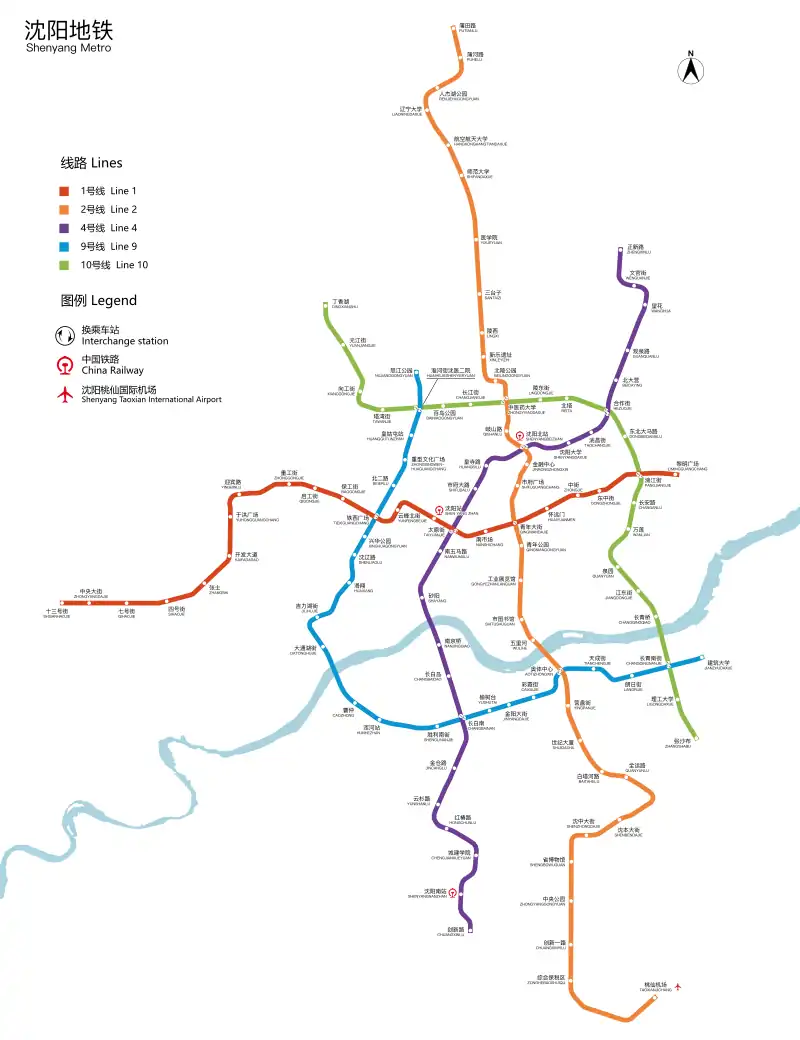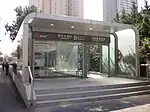Shenyang Metro
The Shenyang Metro is a rapid transit system serving the city of Shenyang, Liaoning, China. It's the seventh operational subway system in Mainland China and the first in Northeast China.
| Shenyang Metro | |||
|---|---|---|---|
| Overview | |||
| Native name | 沈阳地铁 | ||
| Locale | Shenyang, China | ||
| Transit type | Rapid transit | ||
| Number of lines | 5 | ||
| Number of stations | 122 | ||
| Daily ridership | 1.072 million (2021 daily)[1] 391 million (2021 annual)[1] | ||
| Website | http://www.symtc.com/ | ||
| Operation | |||
| Began operation | 27 September 2010 | ||
| Technical | |||
| System length | 163 km (101 mi) | ||
| |||
| Shenyang Metro | |||||||
|---|---|---|---|---|---|---|---|
| Simplified Chinese | 沈阳地铁 | ||||||
| Traditional Chinese | 瀋陽地鐵 | ||||||
| |||||||
The system connects with the Shenyang Modern Tram system in the southern part of the city.[2][3]
Overview
The Shenyang Metro consists of Line 1 (east-west), opened on September 27, 2010, with 27.8 km (17.3 mi) of track and 22 stations, and Line 2 (north-south), opened on January 9, 2012, with 27.16 km (16.88 mi) of track and 22 stations. Line 9 opened on May 25, 2019. The line is 28.996 km (18.017 mi) in length. Line 10 opened on April 29, 2020.[4]
The construction of Line 1 started on November 18, 2005. Trial service not open to the public started in September 2009, with the line fully operational in September 2010.[5] The total cost of Line 1 was 8.88 billion yuan (USD 1.1 billion).
The construction on Line 2 started on November 18, 2006, with 19 stations and 19.3 km (12.0 mi) and became operational on January 9, 2012.[6]
A Line 2 extension to Hangkonghangtiandaxue station opened on December 30, 2013. Another extension to Putianlu station opened on April 8, 2018.[7]
The original loop line is broken into two "L"-shaped lines, Line 9 and Line 10, that intersect twice to form a loop. Line 9 opened on May 25, 2019. The line is 28.996 km (18.017 mi) in length. Line 10 opened on April 29, 2020.[4]Line 4 opened on September 29, 2023.[8]
Lines

| Line | Terminals (District) |
Commencement | Newest Extension |
Length km |
Stations | |
|---|---|---|---|---|---|---|
| 1 | Shisanhaojie (Tiexi) |
Limingguangchang (Dadong) |
2010 | - | 27.8 | 22 |
| 2 | Putianlu (Shenbei) |
Taoxianjichang (Hunnan) |
2012 | 2023 | 45.58 | 33 |
| 4 | Zhengxinlu (Dadong) |
Chuangxinlu (Hunnan) |
2023 | - | 34.112[9] | 23 |
| 9 | Nujianggongyuan (Huanggu / Yuhong) |
Jianzhudaxue (Hunnan) |
2019 | - | 28.996 | 23 |
| 10 | Dingxianghu (Yuhong) |
Zhangshabu (Hunnan) |
2020 | - | 27.2 | 21 |
| Total | 163.7 | 122 | ||||
History

Shenyang was one of the first Chinese cities with a metro plan. The initial plan of building a metro system in Shenyang was proposed as early as 1940, during the Manchukuo era with an Osaka-based company proposing a 52-kilometre (32 mi) metro network.[10][11] However, chaos caused by the Second Sino-Japanese War and Chinese Civil Wars meant the plan was not implemented.[12]
After the wars, the metro program was revived again when the Chinese government decided that the four biggest cities at that time, Beijing, Shanghai, Tianjin and Shenyang should build metro systems for transportation and military purposes. The subway was envisioned to also function as an air raid shelter in an event of war.[12]
Construction in of the metro started in 1965 but was stopped shortly after due to the turmoil from the Cultural Revolution. Only the initial sections of the Beijing Subway and Tianjin Metro managed to be completed. Construction was restarted in 1974, on a line following today's Line 1. In 1978 with government personnel from Harbin, Tianjin and Shanghai visiting to Shenyang to learn about the subway construction experience.[13]
In 1982, subway construction was halted due to lack of funds and resources. The approximately 3 km (1.9 mi) long half completed tunnel was abandoned and filled with water.[13] While the Shanghai Metro was put into service in 1995, the economic decline of Shenyang during the 1980s-1990s meant that there was no capital available for subway construction and the program was continually postponed.
A light rail system was designed in the early 1990s as a cheaper alternative, however this plan was also abandoned after a national suspension of subway projects was declared due to worries of high cost and financial debt.[14]
Shenyang's economy revived in 2000, and with it growing traffic congestion and pollution caused by the expanding urban population. This prompted the Chinese central government to approve the subway proposal on November 8, 2005.[15][16] Construction of the first phase of Line 1 started on November 18, 2005, with the entire phase opened on September 27, 2010, after trial operation in September 2009.[16] The line have 22 stations and went from Shisanhaojie to Limingguangchang station. Line 2 started trail operation on December 30, 2011[17] and was fully opened on January 9, 2012. Line 2 extended three times in 2013 , 2018 and 2023, currently has 33 stations, connecting the downtown Shenyang and Taoxian Airport. Line 9 opened on May 25, 2019. Line 10 opened on April 29, 2020. Line 4 opened on September 29, 2023.[4]
Future development
There are five lines/extensions under construction.
| Planned opening | Route | Terminals | Length (km) | Stations | Status | |
|---|---|---|---|---|---|---|
| 2024 | 3 (Phase 1) | Baomaxingongchang | Xintaijie | 41.27[18] | 30[18] | Under construction |
| 2025 | 1 (Eastern extension) | Limingguangchang | Shuangma[19] | 16.5[20] | 10[20] | Under construction[21] |
| 2026 | 6 (Phase 1) | Yalujiangbeijie[19] | Shaliulu[19] | 27[22] | 23[22] | Under construction[23] |
| 2028 | 9 (Eastern extension) | Jianzhudaxue | Shimiaozi[24] | 7.7 | 5 | Under construction[24] |
| 2029 | 10 (Southern extension) | Zhangshabu | Dingxiangjie[24] | 24.5 | 16 | Under construction[24] |
Network map
See also
References
- "运送乘客237.1亿人次,新增运营里程1168公里…2021年城市轨道交通运营成绩单". 2022-01-13. Retrieved 19 July 2022.
- "Shenyang tram network construction begins". Railway Gazette. Railway Gazette. 21 February 2012. Archived from the original on 2013-05-02. Retrieved 2012-09-16.
- "北车投资48.6亿建设沈阳浑南新区有轨电车". www.zacliu.com. www.zacliu.com. 21 February 2012. Archived from the original on 2012-08-31. Retrieved 2012-09-16.
- "沈阳地铁十号线一期工程定于4月29日开通运营". Archived from the original on 2021-03-01. Retrieved 2020-04-28.
- "Shenyang metro Line 1 fully operational". Railway Gazette. October 1, 2010. Archived from the original on September 8, 2013. Retrieved February 25, 2013.
- "Shenyang metro opens second line". Railway Gazette. January 24, 2010. Archived from the original on November 29, 2021. Retrieved February 25, 2013.
- "沈阳地铁二号线北延线新四站正式开通-辽宁频道-东北新闻网". liaoning.nen.com.cn. Archived from the original on 2018-04-14. Retrieved 2018-04-14.
- 沈阳地铁. "9月29日!沈阳地铁2号线南延线、4号线开通运营". Weixin Official Accounts Platform. Retrieved 2023-10-01.
- "沈阳地铁4号线实现全线轨通".
- Shenyang subway net Archived 2007-05-27 at the Wayback Machine
- "沈阳地铁大事记(1940年-2010年)_沈阳公交网". 2012-01-05. Archived from the original on 2012-01-05. Retrieved 2017-09-10.
{{cite web}}: CS1 maint: bot: original URL status unknown (link) - "沈阳地铁70年之痒". finance.ifeng.com. 2011-08-18. Archived from the original on 2017-08-31.
- "沈阳地铁集团有限公司-新闻中心". www.symtc.com. Archived from the original on 2017-08-31. Retrieved 2017-12-10.
- "国务院办公厅关于暂停审批城市地下快速轨道交通项目的通知_政府信息公开专栏". www.gov.cn. Archived from the original on 2017-08-31. Retrieved 2017-12-10.
- "People's Daily Online -- Subway construction plan for Shenyang ratified". en.people.cn. Archived from the original on 2018-11-29. Retrieved 2017-12-10.
- "沈阳地铁官网网站". 2014-08-14. Archived from the original on 2014-08-14. Retrieved 2017-12-10.
- 王晓婷 (2011-12-30). "沈阳地铁二号线今日开通 市民可持试乘票免费乘车". 沈阳晚报. Archived from the original on 2013-09-25. Retrieved 2012-02-23.
- "沈阳地铁3号线开工". 2019-12-29. Archived from the original on 2019-12-29. Retrieved 2019-12-31.
- "串联"三站一场" 延展"空铁联运"格局". 2023-08-16.
在建5条线路,分别为地铁1号线东延线(黎明广场站-双马站)、2号线南延线(全运路站-桃仙机场站)、3号线(铁西宝马新工厂-新泰街)、4号线(正新路站-创新路站)、6号线(鸭绿江北街站-沙柳路站)
- "地铁1号线东延线年内开工 2025年拟通车-新华网". m.xinhuanet.com. Retrieved 2022-02-21.
- 网易 (2022-01-24). "沈阳地铁1号线东延线传来最新消息!真快!". www.163.com. Retrieved 2022-02-21.
- "沈阳地铁6号线23座车站详细出入口位置定了!快看家门口有站吗-本地新闻-沈阳乐居网". sy.leju.com. Retrieved 2022-02-21.
- "中铁十局城轨公司承建沈阳地铁6号线首开段正式开工!--见道网". www.facebook.com (in Chinese). Retrieved 2022-02-21.
- "『沈阳』地铁9号线二期、10号线二期同步开工建设".
External links
- Shenyang Metro (in Chinese)
- UrbanRail: Shenyang